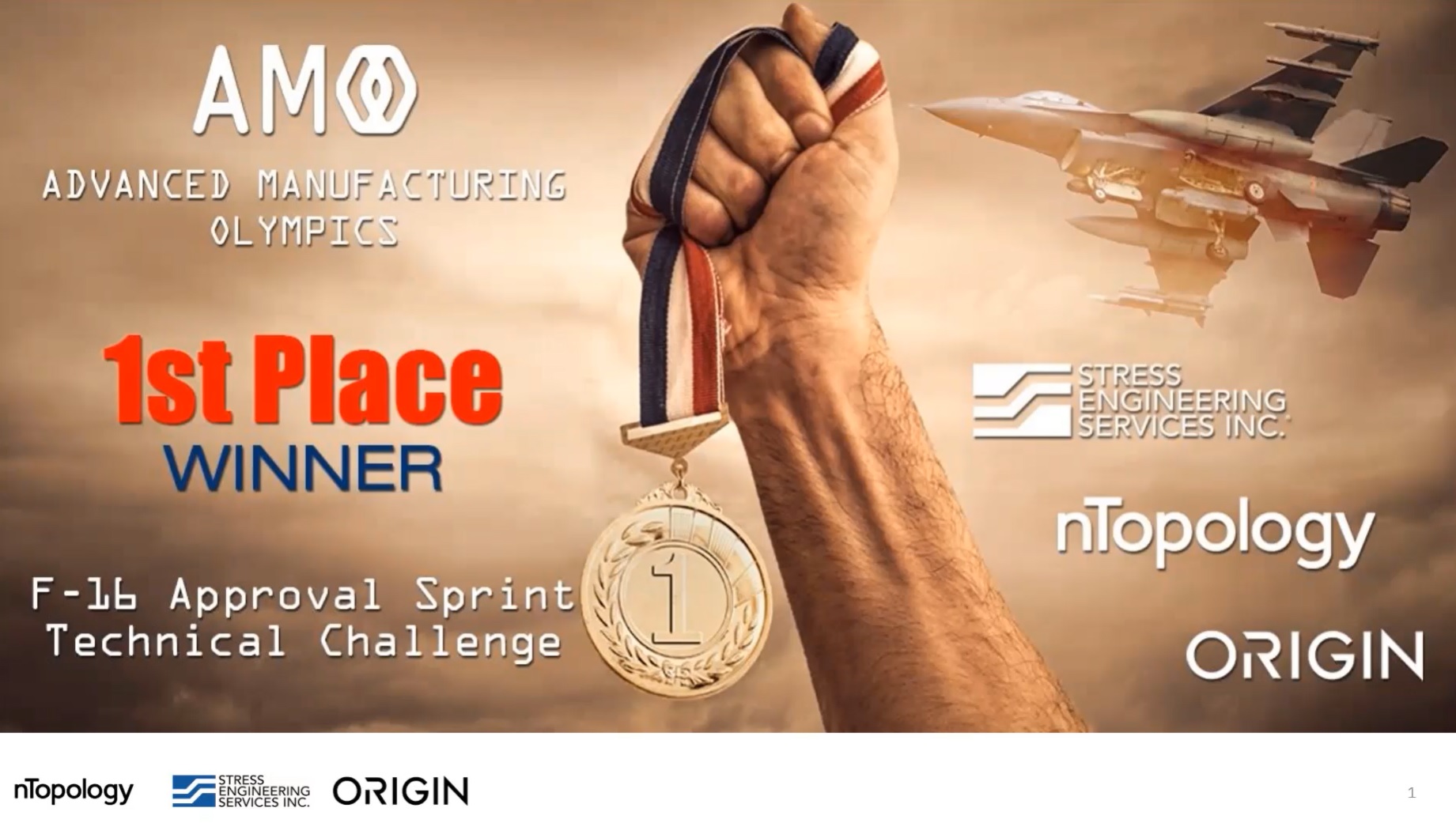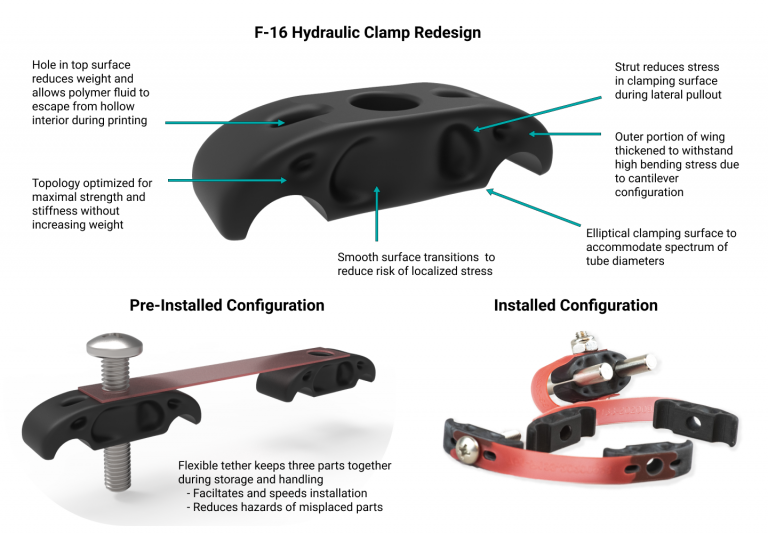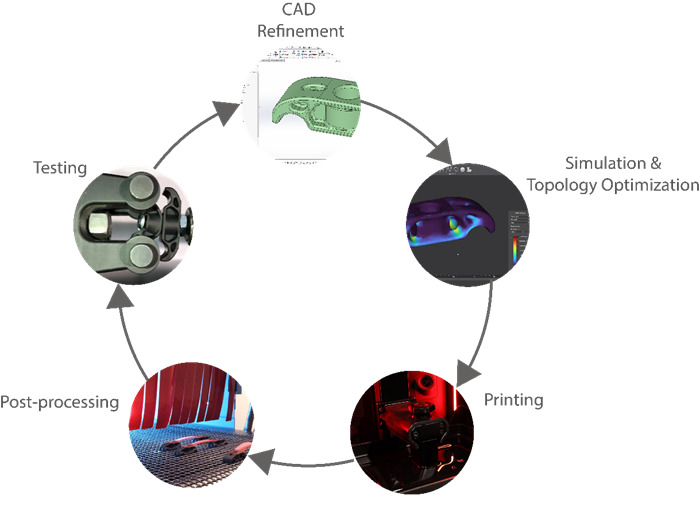Just at the end of last month, we reported on the inaugural Advanced Manufacturing Olympics, organized by the Rapid Sustainment Office (RSO) of the US Air Force. In that story, we relayed the fact that that a team led by Origin had been selected to participate. Origin, the California-based company behind the Origin-One programmable photopolymer 3D printer, teamed up with generative design and topology optimization software provider, nTopology, and Texas-based engineering consulting firm, Stress Engineering Services, to compete in the Approval Sprint challenge. At the main virtual event October 20-23, the team was awarded 1st prize.
This unique virtual event, the Advanced Manufacturing Olympics had five challenges focused on additive manufacturing and reverse engineering methods: the Technical Data Package Relay, Box of Parts Floor Exercise, Material Hurdles, Supply Chain Marathon, and the Approval Sprints. The approval sprints required teams to address rapid production needs for Air Force fleets, by designing, analyzing and delivering an additively manufactured replacement solution to traditional parts, with equivalent performance, that can be rapidly deployed to sustain the operations of an F-16 Fighter Jet. As the challenge website states,
“Advanced manufacturing technologies are capable of rapid production for sustainment; however, it is difficult to exploit these capabilities without radical improvement to Air Force certification methods and timelines in the approval of new materials, processes, and components. Selected Approval Sprint teams will compete to deliver a polymer additively manufactured replacement solution for rapid deployment of a specified F-16 aircraft component. The goal of this technical challenge is to identify innovative strategies for rapid design, qualification and deployment of sustainment solutions which leverage new manufacturing materials, processes, and components.”
The Approval Sprint challenge, which kicked-off end of August this year, awarded $100,000 for the winning team with potential for being contracted by the US Air Force.The prize-winning team led by Origin had already started collaborating remotely in September, combining nTopology’s design solutions and Stress Engineering’s expertise to develop a viable solution to a very challenging F-16 component issue. The part in question was a hydraulic tube clamp for the F-16 Fighting Falcon (considered the world’s most successful combat-proven fighter jet). The clamp, part of the C1375 family of hydroclamps that are used in the thousands in the Air Force’s F-16 fleet, is a component located in the landing gear cavity of the F-16’s and its geometry or design is from 1966. These parts often fail, due to the impact of ‘extended exposure to vibrations, chemical environments, and heat cycling.’ In addition, the traditional manufacture of the clamp component generates toxic formaldehyde gas, is expensive to produce and has long lead times.
The winning multi-material clamp component—designed on the nTopology platform, 3D printed on the Origin One 3D printer, and validated by Stress Engineering Services—was selected from among eight competing entries, including other companies Stratasys, Markforged, and the National Institute for Aviation Research (NIAR). The multi-material part from the Origin team was made using Loctite 3955, a flame-retardant, chemically resistant material, and an elastomer IND402 for the tether material, both developed by Henkel, which Origin has partnered with in its Open Materials program since 2015. The part, with clamp pair and tether 3D printed in a single build, successfully met challenge requirements – spanning dimensional accuracy, stresses/loads, flammability compliance, temperature ratings, jet fuel exposure, vibration tolerance, hydraulic fluid exposure, and engine oil exposure.
For this winning solution, production time for a batch of 54 clamp halves was at 24 minutes, with 1,296 potentially printable in a day, post-processing for a batch took 20 minutes, and part cost was at $1.25. The AM component had double the stiffness of the traditional clamp, was 5% lighter, could easily be assembled by one-hand, and manufactured on-demand. Even during the pandemic, the three members of the team collaborated remotely, across three time zones, undertook more than 30 design iterations, undertook over 100 tests, and printed over 400 parts, to finally produce a winning solution in just 30 days. The part was also serialized during print to ensure part traceability, provenance and inventory management, adding yet another AM advantage in improving supply chain efficiency and reliability.
“We look forward to working with the Airforce Research Laboratory and the Airforce Life Cycle Management Center to build out official Technical Data Package for an increasing amount of 3D printed parts,” said Chris Prucha, co-founder and CEO at Origin.
The possibility of an Air Force contract for Origin is more likely now with their demonstrated additive manufacturing, design and workflow solution in mission-critical component development and replacement. For the company, founded in 2015 and led by Apple and Google, this is tremendous validation of their open platform approach in additive manufacturing production, having launched their Programmable Photopolymerization (P3) technology-based Origin One 3D printer just last year.
nTopology also hosted a webinar to present their story and process in developing the winning clamp design and solution. The generative design software company had just closed $40 million last month in Series C funding and in October, had signed distribution agreement with NTT DATA XAM Technologies to advance AM in the Japanese market.
“We are honored and humbled by our first-place finish in the Approval Sprint Technical Challenge for the Advanced Manufacturing Olympics,” said Dr. Ryan O’Hara, Technical Director Of Aerospace and Defense at nTopology. “Working alongside stellar teams at Origin and Stress Engineering proved to be both easy and rewarding. This is proof that combining all areas of expertise: design, analysis, and manufacturing can lead to unprecedented innovation and product design.”
Matt Sanders, Stress Engineering Services team leader commented, “We were extremely grateful for the opportunity to participate in this challenge with Origin and nTopology. They are two outstanding companies on the cutting edge of AM technology. Our team was able to find ways to collaborate and be innovative together virtually during this challenging pandemic.”
As planes, satellites, equipment and infrastructure age, US Air Force is fundamentally looking for innovative strategies to reduce the astronomical costs of maintaining operational airforce fleets and infrastructure while also boosting readiness.
In such applications, AM is critical to not only reducing these costs, but providing real-world advanced manufacturing solutions and digital workflows as sustainable, efficient, better performing alternatives to traditional mission-critical part supply, maintenance, replacement, deployment, and repeatability.
Subscribe to Our Email Newsletter
Stay up-to-date on all the latest news from the 3D printing industry and receive information and offers from third party vendors.
Print Services
Upload your 3D Models and get them printed quickly and efficiently.
You May Also Like
The Market and Industry Potential of Multi-Material 3D and 4D Printing in Additive Electronics
Additive manufacturing leverages computer-based software to create components for products by depositing either dielectric or conductive materials, layer by layer, into different geometric shapes. Since its birth in the 1980s,...
3DPOD 262: Bio-inspired Design for AM with Dhruv Bhate, Arizona State University
Dhruv Bhate is an associate professor at Arizona State University. There, he looks at structures, materials, and design. Previously, he worked at PADT as well as in the semiconductor and...
3DPOD 261: Tooling and Cooling for AM with Jason Murphy, NXC MFG
Jason Murphy´s NXC MFG (Next Chapter Manufacturing) is not a generalist service; instead, the company specializes in making tooling. Using LPBF and binder jet, the company produces some of the...
3DPOD 260: John Hart on VulcanForms, MIT, Desktop Metal and More
John Hart is a Professor at MIT; he´s also the director of the Laboratory for Manufacturing and Productivity as well as the director of the Center for Advanced Production Technologies....





































